The flight from Chicago to Nagoya was about 13 hours, daylight the entire way, leaving Chicago about 1 PM and arriving Nagoya about 4 PM, making for a long day, especially as I still had to take the Shinkansen (Bullet Train) from downtown Nagoya to Tokyo that same evening. The flight, though, on my $600 ticket was pleasant, the more so for my having been “bumped-up” to business class. About halfway through the flight, I awoke to find we were passing over the mountains and glaciers of Alaska (or Northern Canada?):

Mountains from plane window

Glacier
Arriving at the new airport in Nagoya, my first stop was the men’s room, where I found (some of the) stalls were not quite what I was used to (very clean though!):

The next afternoon, I began my sightseeing Tokyo, stopping briefly by the Imperial Palace grounds (where I saw very little), then walking on to the Tokyo International Forum, then to the Ginza area for the evening:

Buildings reflected in moat

Tokyo International Forum (‘TIF’)

TIF, ships ribs

Widest view

Another angle
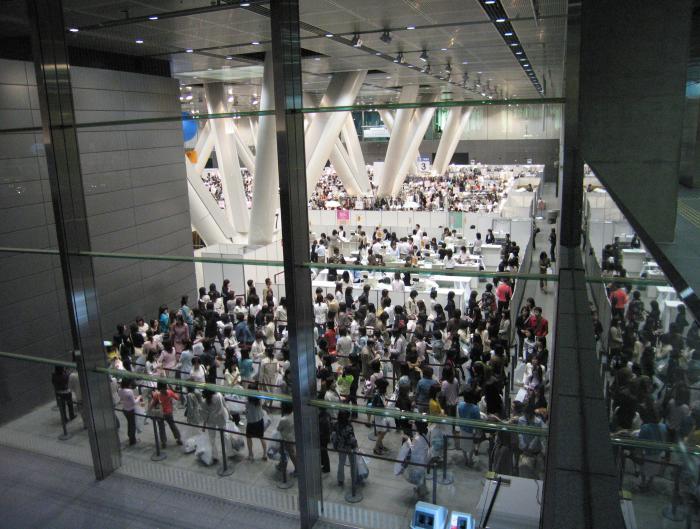
Department store crowd at the TIF complex

Ginza (on Harumi-dori)

Poster close-up
From Ginza, I headed over to Shinjuku, taking the JR (Japan Rail) Yamanote Line (which forms a ring around central Tokyo). Shinjuku is more youth-oriented and a happening place at night:

Shinjuku
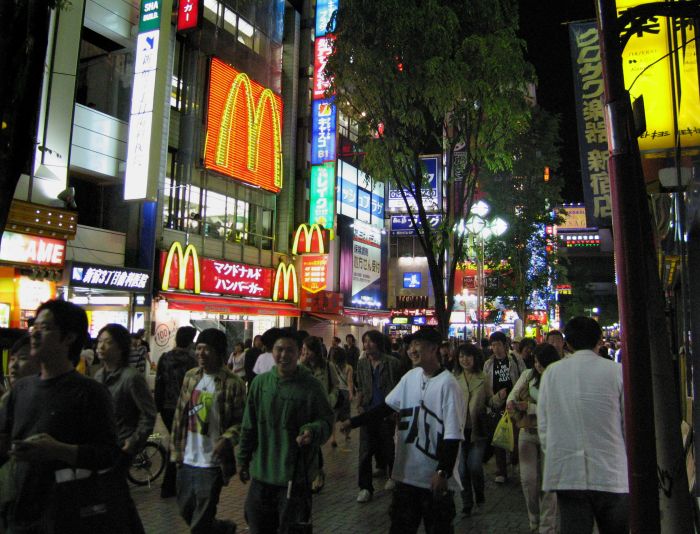
Shinjuku McDonald’s,
guys laughing
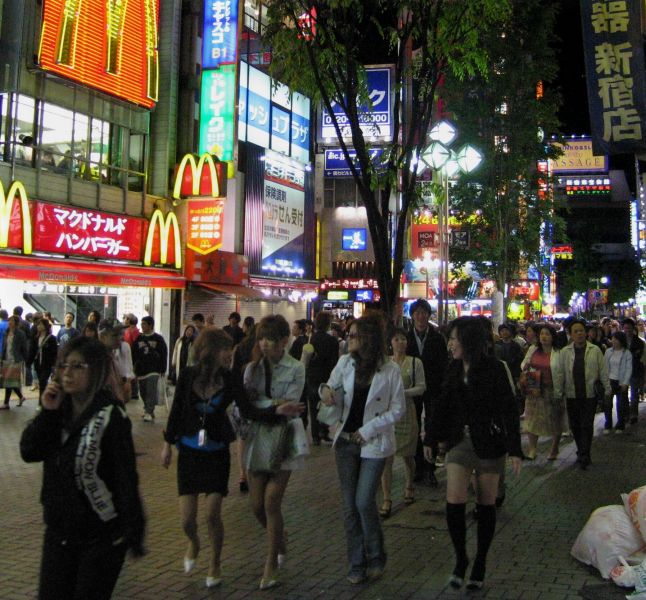
Shinjuku McDonald’s,
girls talking
The the next morning, I took the JR Yamanote Line from my Ikebukuro neighborhood to the Ueno neighborhood, where large Ueno Park is adjacent to the station and the home of some major museums. In and around the station are places to eat, shop and hang-out (even a Starbucks).
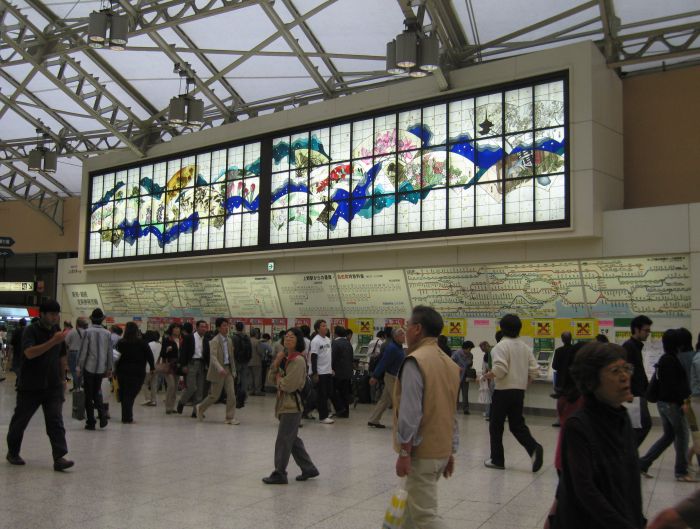
Ueno Station

Ueno Station

Ueno Park

Shop under Ueno Station

Japanese billboard

Copper lanterns,Ueno park
Another morning I set out early for the area on the west side of Shinjuku station, a district of impressive, Western-style, high-rise office buildings. Even though it was 7 AM on a weekday morning and the sun had already been up for a couple of hours, the area was virtually devoid of human activity–desolate. Among the buildings I saw were two designed by well-known architect Tange Kenzo (the Tokyo Metropolitan Government Building and the Park Hyatt Hotel where the movie “Lost in Translation” was filmed):

Copper lanterns,Tange Kenso’s (architect) Tokyo Metropolitan Government Building

View from Park Hyatt (the “Lost in Translation” hotel) toward Metro Government Building
On leaving the Park Hyatt and walking back toward Shinjuku station around 9 AM, the sidewalks were packed with Japanese businessmen, wearing dark suits, flooding out of the station toward the business district. I would say the masses were ‘swarming,’ but for the fact that they actually were rather orderly. I noticed that virtually everyone waited for the walk sign to light before crossing the street, even when no traffic was coming.
Needless to say, Shinjuku station was packed, but I was able to work my way into a position near where one of the carriage doors on the next train into the station would be opening (trains were arriving/departing every couple minutes). When the train arrived, doors opening, guys were bouncing/jostling out of the car (exiting) in a steady stream of fits and starts, like sardine pinball billiards powered by compressed gas. Once they were out, we flooded into the car, which, to accommodate the rush hour crowds, had no seating. Everyone would stand, packed tight. I considered myself fortunate, as one of the first to board, that I could stand by one of the windows on the far side of the car, able to see the passing scenery on a beautiful morning.
I held my briefcase between my legs until there was room to set it in front of me on the window ledge.
By the time we got halfway around the loop toward Ueno (again on the Yamanote line), the car was mostly empty and passengers were sitting (apparently the seats had been folded up against the wall during the crowded part of the loop?).

JR car interior

JR Yamanote Line, as seen through the engineer’s cab

Ueno Station platform
At Ueno station, I got the Ginza Line (subway) to Asakusa to pick up the Tobu Nikko train to Nikko. The Tobu Nikko station was under the Matsuya department store, where I bought a bento box lunch in the basement. Nikko, a smallish town about an hour and a half from Tokyo, is the home of the World Heritage-listed shrine complex of TÇshÇ-gã. The weather was partly sunny when I left Tokyo, but by the time I arrived in Nikko, heavily overcast . . . but, what can you do?

Shin-kyo bridge, Nikko

Tosho-gu complex

5-tier pagoda at Nikko’s Tosho-gu

Seated archer

Roof detail
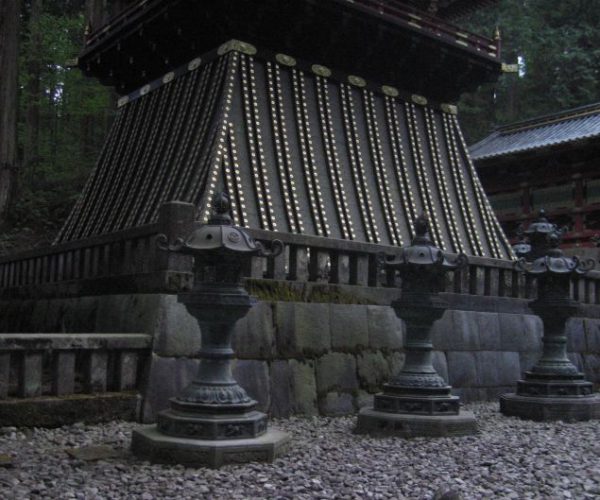
Detail at Taiyuin-byo
The next afternoon, I happened to be in the vicinity of the Ginza Kabuki theater, as it was nearing time for the late afternoon show to begin. This would be a 3-hour performance, but, for the benefit of tourists or others who don’t want to commit to 3 hours, it is possible to buy a ticket for a single act. I decided to buy a ticket to the first act, which would last about an hour and ten minutes, standing room only. It was warm in the theater and I was tired. The usual elements of Kabuki were present–the white painted faces, the voices, the instruments (especially that distinctive-sounding stringed instrument that would be struck irregularly) and the shouting out from audience ‘shills.’
Of course, the language of the performance was Japanese, and I didn’t understand a word of it. There was almost no action. Virtually all my interest in the performance was gone after 10 or 15 minutes. I considered leaving early but resolved to tough it out for the next hour, so as not to lose face with or disturb the Japanese audience around me. Yet I was tired standing, shifting around, leaning on the rail or the back wall in one posture or another. I found it very difficult to stay awake. In fact, I nearly fell asleep on my feet twice, once awaking just as my knees started to buckle (and catching myself) but imagining how embarrassing it would be as an ‘uncultured gaijin’ to pass out on the floor from sleep in the middle of a Japanese national treasure. Finally I got up the nerve to simply walk out, others think what they would.

Entrance Ginza Kabuki theater
After walking out, I stopped at an inviting looking coffee bar for an exotic smoothie (Y490), which turned out icy. Good tables with views were available, but I was self-conscious and soon driven out by the faint but unsalutary smell of reified cigarette smoke that pervaded the place, seeping up from the smoking room in the basement. I finished my ‘smoothie’ on the street then began my odyssey of finding a place to dispose of my empty cup.
There are no trash cans on Tokyo streets, nor in the railway & subway stations (yet the streets and stations are generally unlittered . . . I guess the Japanese ‘pack it out’). Be that as it may, I had no desire to put a dirty smoothie cup in my briefcase. I recalled that it generally is easy to find public toilets in the train stations (where there are wastebaskets). So, even though I had no other reason to want to go down into the subway on a lovely May evening, I did. In my tiredness or whatnot, I found no restroom. In frustration, I nearly came to the point of abandoning my cup between planters, but I just couldn’t do it–if the Japanese can be neat, dammit, so can I!
Finally I considered that all the restrooms I’d seen in stations were perhaps only to be found once having purchased a ticket and passing through the turnstiles. I asked the station attendant who was manning the turnstiles if there might be a place I could dispose of my cup, waving my cup for him to see. He said “no” simply, if not curtly, and I wondered if he understood my question. A restroom I asked, a ‘toilet’ (surely that he would understand, and every station has a toilet). “No,” he said. Could he really have understood? I kept my eyes intensely on his face, annoyed with his attitude and asked, “what, no toilet?” No! “None at all?” No! I came very close to raising my voice in outraged anger but instead simply walked away, thus, as I understand it, not losing ‘face.’ Shortly thereafter, I found an appropriate place to dispose of the cup (I don’t remember where . . . maybe a McDonald’s).
he next day, I was back in Asakusa to see the Senso-ji (also known as Asakusa Kannon), the most venerable of Tokyo’s Buddhist temples.

Student’s gathered in front of Asakusa Kannon shop district

Department store crowd Shopping crowds on the way to Senso-ji

Shopping crowd, four girls waiting

A proprietor with his wares

Fans

Department store crowd Two older women exit Senso-ji

Entrance arch seen from Senso-ji
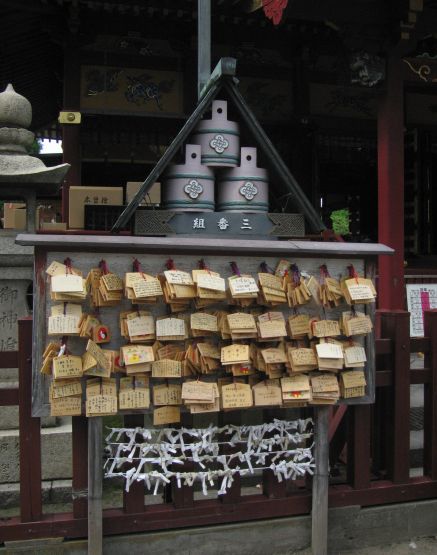
Messages of probable
spiritual import

Department store crowd Asakusa arcade entrance, night

5-tiered pagoda
I should say something about my lodging in Tokyo. I stayed at the Kimi Ryokan, near the Ikebukuro station (JR Yamanote Line). Arriving at the Kimi, I checked shoes in the rack by the entrance and signed in as a guest (in room 305). I would say the Kimi is somewhat of a cross between a traditional, Japanese ryokan (lodging) and a youth hostel . . . very reasonably priced at Y4500 (about $45) a night, but somewhat lacking in amenities. My room was very poorly lit–dark & gloomy, even on sunny day.
The showers and the bathrooms were communal. There was no rack for hanging clothes or towels in the room, nor were there any drawers, just 3 wall hooks . . . no wastebasket. The room did, however, have genuine tatami matting on the floor, which I found very nice–as warm as carpeting and as padded, in fact, nicer in it’s firmness, and more elegant. There was some framed calligraphy on the wall, but it was really bad . . . maybe so nobody would be tempted to steal it. There was one sliding window shade made with rice paper.
I had expected the staff here to be very friendly and helpful with all the ins and outs of Tokyo and otherwise, maybe even to spend time hanging out with guests in the lounge or something . . . none of this was the case. On the other hand, on my first night, after taking my shower, relaxing in my yakata, I found the most convivial group of fellow travelers in the lounge. There was the woman from Macedonia (earthy and reminding my of a mature hippie flowergirl, free with her opinions, positive, enjoying the company), her husband from Germany, and their young son (who speaks Dutch, as they now live in Holland).
There were the four ‘youth’ in the UNESCO? student program, studying abroad in Japan . . . also very friendly and convivial . . . two of the girls were from Indonesia (Jakarta), one guy was from India and the other from the Philippines. I found I could relate well with each, comfortable and relaxed and knowing something about each of their cultures. It turned out it was the last night in town for each of them, so we said our farewells at the end of the evening. Back in my room, I found I had to guard against my ‘worldly wise ways’ going to my head.


Kyoto:I took a cab from Kyoto station to east Kyoto, where I was staying at a small, family-run, Japanese-style inn with only 4 guest rooms (Kiyomizu Sanso). I was genuinely relieved and delighted to see the beautiful, traditional-style wooden housing and shops along the narrow, one lane, stone-paved lane, Sannan-zaka, as we approached my lodging. The inn was just a short 20 meter passageway off of Sannen-zaka!
My hostess met me at the door. She is a genuinely gracious and friendly person, who, with limited English, made me feel warmly welcome. She is truly well-suited to being a hostess and does a lot of good in the world!
The inn and my room are quaint and beautiful, as befits a lodging in this neighborhood. All of the finishings in my room are of warm, natural materials. A good-sized window with a sliding rice paper screen in a wooden frame looks out on a secluded driveway. The ceiling is covered in natural, light-grained wood ceiling panels with darker wooden cross supports, tatami mats cover the floor, and the walls have a natural, sand-grained finish. There is one low table with seating pads (no chairs). In one corner there is a built-in stand/table, under which luggage can be placed. The bedding is rolled-up (folded) in the closet, to be taken out only for evening use. Guests were expected to make up their own beds, when the time came.
Outside the room’s sliding, rice-paper screens, there is a regular sliding glass window that can be opened for fresh air. The room also has A/C if needed (it won’t be on this trip) and superb lighting–abundant lighting is available, if one wishes, from the circular florescent tubing, partially shrouded in a paper lantern–really rather overpowering. I generally preferred to use, instead, only the fixture’s one dim incandescent bulb (about one candle power) for a nice natural effect.
The seating takes me some getting used to–it can be a little hard on my back. What I’ve found works pretty well for me as I’m typing this journal (on my laptop) is sitting on one folded-in-half floor pad, leaning my back up against the low stand built in to the wall, using another pad to shield my back from its hard edge.
A full Japanese-style breakfast was served by my hostess in my room. It always included a pot of tea, miso soup, and a small crock of rice. Along with this there would be small portions of 8 or 10 other food items, served in a bento box . . . really neat . . . quite elegant . . . nicely presented. I would really enjoyed this and marvel at all this being part of my lodging contract at Y6000 a night.
As far as I could tell, Kiyomizu Sanso was run entirely by our hostess. Being as our rooms were inside her abode (as in a bed-and-breakfast), she would coordinate with her guests when she wanted to do errands during the middle part of the day, as she needed everyone out during this period when she would lock up. Guests did not have a key to the outside door.
[Btw, though my rooms sliding entry door can be latched from the inside at night, my hostess told me there was no key to lock the door from the outside, requesting that I take care to secure my valuables as I see fit. I know theft is rare in Japan, but still, not knowing my fellow-guests, etc., I would have felt better having a key to my room. There seemed to be a keyhole on the outside of the latch, so I wondered why no key was provided. Was it lost? Was it considered unnecessary? Was it only my room that has no key or are all guests rooms the same? I never found out.]
After getting my stuff settled in my room, I set out to explore the delightful Sannan-zaka with my camera and the day’s last couple hours of light. I didn’t go far, fearing I might get lost, as I’d not brought the map the proprietress had provided (though getting lost in the fading light might have been possible even with that map). I stumbled onto the Kiyomizu-dera (temple/shrine?) as I wandered–it was just closing for the day–it would be my first stop the next morning. In the other direction, I passed a silhouetted pagoda on the way to the busy Higashioji-dori (an avenue), where I bought a sashimi package at convenience store for my evening meal.

My room at Kiyomizu-sanso with breakfast on table

Kiyomizu-sanso entrance

Neighborhood pagoda
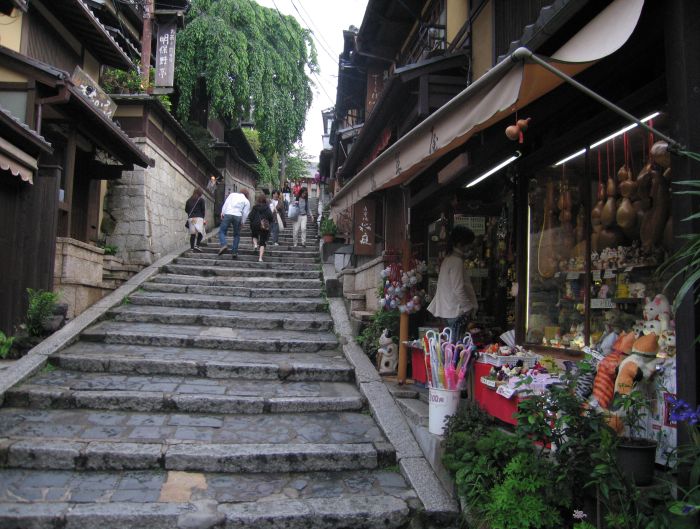
Sannen-saka stairway up

A place to eat

Stairway down

Strollers on Sannen-zaka

A passageway

Roofing ‘gargoyle’
My first morning in Kyoto, I set off to explore Kiyomizu-dera, the Buddhist temple and shrine just up the hill on Sannan-zaka from where I was staying. During the Spring, many students come to see the shrine on school trips.

Student’s walking to Kiyomizu-dera

In the vicinity of Kiyomizu-dera

Striking the resonant vessel

Students posing

Student’s leaning to reach the mystic falling water

Kiyomizu-dera

Worn woodwork

Shrine detail

At Kodai-gi temple

Sparse traditional interior

Interior

Three students pose

Two students

Keith with two students

Graveyard at [unknown] shrine

A statue in a park
Ginkaku-ji was my favorite of all the shrines and temples for its beautiful and mindfullness inspiring landscape–the ridged sculpture with truncated cone to aid in the appreciation of moon viewing, Japanese gardens, tended wooded hillside paths ways, special moss. I met again (chancing to take another picture before realizing) some of the same students pictured earlier. Their teacher pointed out, to my surprised memory, that we’d met earlier . . . I shook his hand in hearty greeting . . . he and his students liked that, with gusto.



A sculpture to aid in the viewing of the moon

A view to an interior

‘Moon view’ stark ridges

VIP moss

Moss and a stump

A worker tends the hillside

A student group on the Ginkaku-ji grounds
Gion : Gion is the section of Kyoto associated with geisha and exclusive evening teahouses. These things do still exist, though, I think it’s relatively rarely that one spots geisha out on the street, so, I count myself fortunate to make a geisha sighting. The three women you see walked in a line on their high wooden sandals taking little steps in unison, accompanied by a female ‘handler.’ They seemed not to take note of their surroundings, maintaining composure, despite any possible indignities associated with the public street and bright sunlight.

Gion Geisha

Gion teahouse, evening

Shop display, food

Interior retail way, Gion

Interior retail way, Gion

Kinkaku-ji

Kinkaku-ji

Shimmering water under eaves

Ryoan-ji, ‘dry garden’

Zen contemplation at Ryoan-ji

Ryoan-ji people
Kyoto has a marvelous new JR train station complex near the center of town which probably should not be missed by those enjoying 21st century shopping and amenities in Japan:

Kyoto JR station exterior

Double-loop at Kyoto station

Kyoto skyline with hazy peak as seen from train station complex

Rail yard below

Girls on ledge

Iced-coffee at sky restaurant
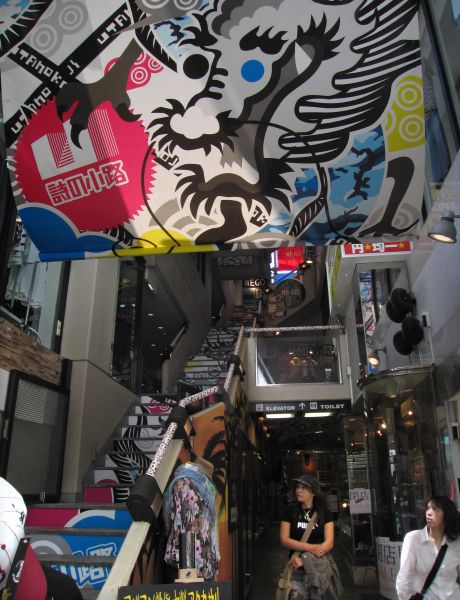
Stairway and screen in arcade

Food

Making mini-hotcakes

Two girls watch

Two girls look out from teahouse toward garden at Murin-an

Nijo-jo grounds, cityscape background

Garden outside Ninomaru palace

Yasaka-jinja

Breakfast at Chitose Inn

Pigeon

Pigeon fluffing

Electrical transformer

Tree in woods on temple ground
I welcome any questions or comments.
To contact me (Keith Stanley), please email me at kesta1001@yahoo.com.
Here are some links to others of my pages: